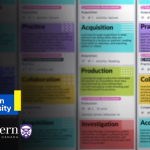Remote Teaching
OER for Remote Teaching
Remote teaching: a practical guide with tools, tips, and techniques
By: Alison Flynn and Jeremy Kerr, University of Ottawa
 This resource is designed to help you convert your face-to-face class to a remote course as simply as possible. We walk you through the process, at each step giving a suggestion for a specific tool/technology—the uOttawa-supported one and our preferred tool if it is different. We also give an example and sources of additional information. We also created a template of a course in Brightspace, syllabus, and other resources that you can modify to suit your own course, if desired.
This resource is designed to help you convert your face-to-face class to a remote course as simply as possible. We walk you through the process, at each step giving a suggestion for a specific tool/technology—the uOttawa-supported one and our preferred tool if it is different. We also give an example and sources of additional information. We also created a template of a course in Brightspace, syllabus, and other resources that you can modify to suit your own course, if desired.
Attribution: Remote teaching: a practical guide with tools, tips, and techniques by Alison Flynn and Jeremy Kerr is licensed under a Creative Commons Attribution-NonCommercial-ShareAlike 4.0 International License, except where otherwise noted.
ABC Online Course Design
By: The Centre for Excellence in Learning & Teaching, Ryerson University, and the Centre for Teaching and Learning, Western University
The goal of ABC Online Course Design is student-centred rapid course development. We are recommending this process for instructors looking to shift their course from in-person to online. This process is flexible enough to be used by:
- Individual instructors
- Instructor teams
- Departments or programs
To participate in ABC Online Course Design, you only need a course outline and a set of learning outcomes.
ABC Online Course Design consists of two components:
- Pre-workshop activities, to be completed on your own (30-40 minutes)
- A course storyboarding workshop, facilitated in Zoom (90 minutes)
If you’d prefer not to attend a workshop, or if one isn’t available at a suitable time, it is also possible to complete ABC Online Course Design entirely on your own, by completing both “Part 1: Preworkshop Activities” and “Part 2: Independent Storyboarding” in your own time.
Attribution: “ABC Online Course Design” by Western University’s Centre for Teaching and Learning and Ryerson University’s Centre for Excellence in Teaching and Learning is an adaptation of the ABC Learning Design method by Clive Young and Natasa Perovic, UCL (2015) and Learning Types, Laurillard, D. (2012), and is made available through an Attribution-NonCommercial-ShareAlike 4.0 International License.
Creating Online Learning Experiences
Edited by: Matt Crosslin, et al., University of Texas at Arlington
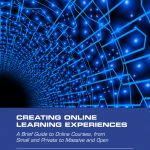 This book provides an updated look at issues that comprise the online learning experience creation process. As online learning evolves, the lines and distinctions between various classifications of courses has blurred and often vanished. Classic elements of instructional design remain relevant at the same time that newer concepts of learning experience are growing in importance. However, problematic issues new and old still have to be addressed. This handbook explores many of these topics for new and experienced designers alike, whether creating traditional online courses, open learning experiences, or anything in between.
This book provides an updated look at issues that comprise the online learning experience creation process. As online learning evolves, the lines and distinctions between various classifications of courses has blurred and often vanished. Classic elements of instructional design remain relevant at the same time that newer concepts of learning experience are growing in importance. However, problematic issues new and old still have to be addressed. This handbook explores many of these topics for new and experienced designers alike, whether creating traditional online courses, open learning experiences, or anything in between.
Attribution: Creating Online Learning Experiences by Matt Crosslin is licensed under a Creative Commons Attribution-NonCommercial 4.0 International License, except where otherwise noted.
Remote Teaching: A Guide for Teaching Assistants
By: Meredith Allen, Alisha Szozda, Jeremy Kerr, and Alison Flynn, University of Ottawa
 This guide is designed to help you effectively and confidently work as a teaching assistant in a remote teaching environment.
This guide is designed to help you effectively and confidently work as a teaching assistant in a remote teaching environment.
Attribution: Remote teaching: a guide for teaching assistants by Meredith Allen, Alisha Szozda, Jeremy Kerr, and Alison Flynn is licensed under a Creative Commons Attribution-NonCommercial-ShareAlike 4.0 International License, except where otherwise noted.
Teaching Health Professionals Online
By: Sherri Melrose, Caroline Park, and Beth Perry, Athabasca University
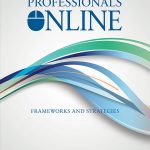 Teaching Health Professionals Online is a must-read for professionals in the health care field who strive to deliver excellence in their online classes. Intended for a wide range of professionals, including nurses, social workers, occupational and radiation therapists, chiropractors, dietitians, and dental hygienists, this compendium of teaching strategies will inspire both new and experienced instructors in the health professions. In addition to outlining creative, challenging activities with step-by-step directions and explanations of why they work, each chapter in the text situates practice within the context of contemporary educational theories such as instructional immediacy, invitational theory, constructivism, connectivism, transformative learning, and quantum learning theory.
Teaching Health Professionals Online is a must-read for professionals in the health care field who strive to deliver excellence in their online classes. Intended for a wide range of professionals, including nurses, social workers, occupational and radiation therapists, chiropractors, dietitians, and dental hygienists, this compendium of teaching strategies will inspire both new and experienced instructors in the health professions. In addition to outlining creative, challenging activities with step-by-step directions and explanations of why they work, each chapter in the text situates practice within the context of contemporary educational theories such as instructional immediacy, invitational theory, constructivism, connectivism, transformative learning, and quantum learning theory.
Attribution: Teaching Health Professionals Online by Sherri Melrose, Caroline Park, and Beth Perry is licensed under a Creative Commons License (CC BY-NC-ND 2.5 CA).
Accessible Elements: Teaching Science Online and at a Distance
Edited by: Dietmar Kennepohl and Lawton Shaw, Athabasca University
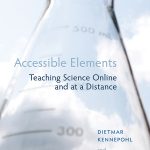 Accessible Elements informs science educators about current practices in online and distance education: distance-delivered methods for laboratory coursework, the requisite administrative and institutional aspects of online and distance teaching, and the relevant educational theory. Delivery of university-level courses through online and distance education is a method of providing equal access to students seeking post-secondary education. Distance delivery offers practical alternatives to traditional on-campus education for students limited by barriers such as classroom scheduling, physical location, finances, or job and family commitments. The growing recognition and acceptance of distance education, coupled with the rapidly increasing demand for accessibility and flexible delivery of courses, has made distance education a viable and popular option for many people to meet their science educational goals.
Accessible Elements informs science educators about current practices in online and distance education: distance-delivered methods for laboratory coursework, the requisite administrative and institutional aspects of online and distance teaching, and the relevant educational theory. Delivery of university-level courses through online and distance education is a method of providing equal access to students seeking post-secondary education. Distance delivery offers practical alternatives to traditional on-campus education for students limited by barriers such as classroom scheduling, physical location, finances, or job and family commitments. The growing recognition and acceptance of distance education, coupled with the rapidly increasing demand for accessibility and flexible delivery of courses, has made distance education a viable and popular option for many people to meet their science educational goals.
Attribution: Accessible Elements: Teaching Science Online and at a Distance by Dietmar Kennepohl and Lawton Shaw is licensed under a Creative Commons License (CC BY-NC-ND 2.5 CA).
Low Bandwidth Teaching and Learning
By: Kyle Mackie
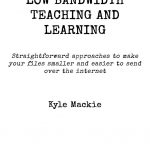 Shifting to remote teaching and learning brings with it a number of considerations and challenges. If learners are able to connect to free/institutional networks (e.g., from local libraries, or on-campus student work areas), they will likely be able to access a safe, reliable, and robust internet connection. However, if these learners are relying on home-based connections, these will likely have a slower speed connection, and their service may be shared with others in their house (for work, or education, or entertainment). While we’re considering activities that lower the bandwidth, it’s also to have a refresher on how to optimize images, PDFs, etc. for effective distribution before you post them to your LMS or send them via email.
Shifting to remote teaching and learning brings with it a number of considerations and challenges. If learners are able to connect to free/institutional networks (e.g., from local libraries, or on-campus student work areas), they will likely be able to access a safe, reliable, and robust internet connection. However, if these learners are relying on home-based connections, these will likely have a slower speed connection, and their service may be shared with others in their house (for work, or education, or entertainment). While we’re considering activities that lower the bandwidth, it’s also to have a refresher on how to optimize images, PDFs, etc. for effective distribution before you post them to your LMS or send them via email.
Attribution: Low Bandwidth Teaching and Learning by Kyle Mackie is licensed under a Creative Commons Attribution 4.0 International License, except where otherwise noted.

